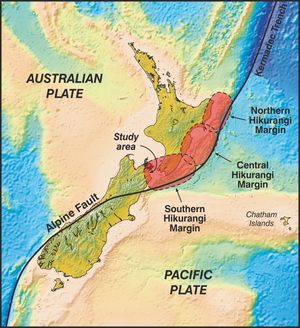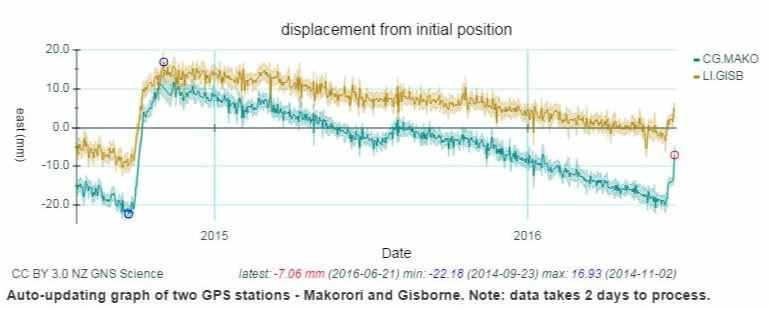Silent 'slow slip' earthquake detected off Gisborne, New Zealand
Radio New Zealand Thu, 23 Jun 2016 03:56 UTC
Diagram showing the Hikurangi Margin.
© GeoNet A silent earthquake's movement is plotted
A 'silent' earthquake that's been happening for a week, and could continue for months, has been detected off the coast of Gisborne.
GeoNet said today that the event, which could move faults at the equivalent of magnitude 5 or higher regular earthquakes, had just been detected and was being monitored.
The slow-motion earthquakes, also known as "slow slips", are undetectable by humans or seismographs, and are instead measured using changes in distance between global positioning system stations across the North Island.
They have been shown to be able to trigger - or alleviate - large, tsunami-generating earthquakes.
Follow slow-slip motion on GeoNet
The agency said a magnitude 4 earthquake off the coast of Gisborne last week was likely related.
The phenomenon is fairly new to science and, after being discovered in the United States, was first located in New Zealand in the early 2000s.
GNS Science seismologist Stephen Bannister said in 2014 the earthquakes occurred every one to two years in the Gisborne area, pushing sections of Poverty Bay eastward by 2-3cm.
They are found around the world in subduction margins, where one tectonic plate is slipping under another into the earth's mantle.
New Zealand scientists and colleagues from the US and Japan have been studying silent earthquakes in the Gisborne and Hawke's Bay areas since May 2014, comparing the timing of earthquakes with the motion of the sea floor.
The group, known as HOBITTS (Hikurangi Ocean Bottom Investigation of Tremor and Slow Slip), was hoping its research could improve scientists' ability to predict earthquake hazards.
===============================================
Something about the above article which needs to be clarified and that's this oxymoron: "silent earthquake"
An earthquake, by definition cannot be "silent." It is the result of a sudden, "explosive" displacement (rupture) that generates mild to heavy "noises" in the form of seismic waves perceived by humans and causing no-to-severe damages.
Accordingly:
- Sudden, explosive rupture/slip = earthquake
The following statement shows how confused the writer of that article is about the whole concept:
- Slow displacement/slip = slow slip
... it's 'silent' because it isn't an earthquake and should have been stated as:A 'silent' earthquake...
What the GPS data show is a periodical/cyclical readjustment of the plates with respect to one another that's non-"explosive"/non-sudden because it occurs over a sufficiently long period of time to be non-detectable by humans or seismographs and which is what a "subduction" is expected to do along its subduction plane.A silent 'earthquake'...
What these data also show is that the subduction plane is sufficiently "greased"/lubricated to allow for these "slow slips" to occur and thereby preventing the accumulation of elastic stress leading to "explosive" release of accumulated energy, i.e. earthquake.
- Home
- Forum
- Chat
- Donate
- What's New?
-
Site Links

-
Avalon Library

-
External Sites

- Solari Report | Catherine Austin Fitts
- The Wall Will Fall | Vanessa Beeley
- Unsafe Space | Keri Smith
- Giza Death Star | Joseph P. Farrell
- The Last American Vagabond
- Caitlin Johnstone
- John Pilger
- Voltaire Network
- Suspicious Observers
- Peak Prosperity | Chris Martenson
- Dark Journalist
- The Black Vault
- Global Research | Michael Chossudovsky
- Corbett Report
- Infowars
- Natural News
- Ice Age Farmer
- Dr. Joseph Mercola
- Childrens Health Defense
- Geoengineering Watch | Dane Wigington
- Truthstream Media
- Unlimited Hangout | Whitney Webb
- Wikileaks index
- Vaccine Impact
- Eva Bartlett (In Gaza blog)
- Scott Ritter
- Redacted (Natalie & Clayton Morris)
- Judging Freedom (Andrew Napolitano)
- Alexander Mercouris
- The Duran
- Simplicius The Thinker








 Reply With Quote
Reply With Quote


Bookmarks